Multi-Layer Molecular Quantum-Dot Cellular Automata Multiplexing Structure with Physical Verification for Secure Quantum RAM
Abstract
1. Introduction
- Design of a 5 × 5 × 1 novel ultra-slim vertical panel type 2-to-1 Mux that is completely different from the existing molecular QCA-based multi-layer structure Mux.
- Physical verification through multiple lemmas and examples to prove the design principle of the proposed multi-layer 2-to-1 Mux.
- Design of a 4-to-1 Mux using three 2-to-1 Muxes to demonstrate the easy expansion of the proposed unit Mux.
- Design of an 8 × 13 × 1 vertical panel type RAM cell using the proposed unit Mux to demonstrate the modularity and easy application.
- The proposed structure demonstrates innovative excellence in all performance metrics and standard design costs compared to existing multi-layer Muxes.
- To design a safe quantum RAM circuit, the polarization of the output signal was maximized and noise was minimized.
2. Results
2.1. Proposed Vertical Panel Type 2-to-1 Multiplexer and Its Expansion and Application
2.2. Physical Verification of 2-to-1 Multiplexer
- 1.
- The size of each cell is 18 nm × 18 nm.
- 2.
- Each cell has a 2 nm distance from neighboring cells in the same layer.
- 3.
- The distance between each layer is 11.5 nm.
- 4.
- The radius that can affect electrons is 65 nm.
- 5.
- Four quantum dots are located at each corner of a square cell.
3. Discussion
4. Materials and Methods
4.1. Basic Knowledge of QCA
4.2. QCA-Based Multi-Layer Multiplexer
5. Conclusions
Funding
Data Availability Statement
Conflicts of Interest
References
- Jin, L. T5 What makes Moore’s law continue?-Recent advances in semiconductor. In Proceedings of the 7th International Conference on ASIC, Guilin, China, 22–25 October 2007; p. 12. [Google Scholar]
- Lent, C.S.; Tougaw, P.D.; Porod, W. Quantum cellular automata: The physics of computing with arrays of quantum dot molecules. In Proceedings of the Workshop on Physics and Computation, Dallas, TX, USA, 17–20 November 1994; Volume 17, pp. 5–13. [Google Scholar]
- Tougaw, P.D.; Lent, C.S. Logical devices implemented using quantum cellular automata. J. Appl. Phys. 1993, 75, 1818–1825. [Google Scholar] [CrossRef]
- Sadoghifar, A.; Heikalabad, S.R. A Content-Addressable Memory structure using quantum cells in nanotechnology with energy dissipation analysis. Phys. B Condens. Matter 2018, 537, 202–206. [Google Scholar] [CrossRef]
- Jeon, J.C. Low-complexity QCA universal shift register design using multiplexer and D flip-flop based on electronic correlations. J. Supercomput. 2020, 76, 6438–6452. [Google Scholar] [CrossRef]
- Kianpour, M.; Sabbaghi-Nadooshan, R. A novel quantum-dot cellular automata x-bit × 32-bit SRAM. IEEE Trans. Very Large Scale Integr. VLSI Syst. 2016, 24, 827–836. [Google Scholar] [CrossRef]
- Dehkordi, M.A.; Shamsabadi, A.S.; Ghahfarokhi, B.S.; Vafaei, A. Novel RAM cell designs based on inherent capabilities of quantum-dot cellular automata. Microelectron. J. 2011, 42, 701–708. [Google Scholar] [CrossRef]
- Mubarakali, A.; Ramakrishnan, J.; Mavaluru, D.; Elsir, A.; Elsier, O.; Wakil, K. A new efficient design for random access memory based on quantum dot cellular automata nanotechnology. Nano Commun. Netw. 2019, 21, 100252. [Google Scholar] [CrossRef]
- Jeon, J.C. Quantum-Dot CA-Based Fredkin Gate and Conservative D-latch for Reliability-Based Information Transmission on Reversible Computing. Electronics 2024, 13, 2872. [Google Scholar] [CrossRef]
- Seo, D.K.; Jeon, J.C. QCA-Based Secure RAM Cell Structure Using Logic Transformation and Cell-interaction with Signal Reliability and Energy Dissipation in Quantum Computing. Appl. Sci. 2023, 13, 9998. [Google Scholar] [CrossRef]
- Azimi, S.; Angizi, S.; Moaiyeri, M.H. Efficient and Robust SRAM Cell Design Based on Quantum-Dot Cellular Automata. ECS Solid State Sci. Technol. 2018, 7, 38–45. [Google Scholar] [CrossRef]
- Akbari-Hasanjani, R.; Sabbaghi-Nadooshan, R. Tree router design using a novel optimal QCA DEMUX. Nano Commun. Netw. 2023, 35, 100439. [Google Scholar]
- Sardinha, L.H.B.; Costa, A.M.M.; Neto, O.P.V.; Vieira, L.F.M.; Vieira, M.A.M. NanoRouter: A Quantum-dot Cellular Automata Design. IEEE J. Sel. Areas Commun. 2013, 31, 825–834. [Google Scholar]
- Klicnik, O.; Munster, P.; Horvath, T. Multiplexing Quantum and Classical Channels of a Quantum Key Distribution (QKD) System by Using the Attenuation Method. Photonics 2023, 10, 1265. [Google Scholar] [CrossRef]
- Ansarian Najafabadi, S.; Rezai, A.; Ghasvarian Jahromi, K. Novel circuit design for reversible multilayer ALU in QCA technology. J. Comput. Electron. 2022, 21, 1451–1460. [Google Scholar] [CrossRef]
- Jeon, J.C. Design of Fixed Cell-Based Programmable Logic Gate Using Quantum-Dot CA for Efficiency and Reliability of Digital Systems. IEEE Access 2024, 12, 187868–187876. [Google Scholar] [CrossRef]
- Patidar, M.; Singh, U.; Shukla, S.K.; Prajapati, G.K.; Gupta, N. An ultra-area-efficient ALU design in QCA technology using synchronized clock zone scheme. J. Supercomput. 2023, 79, 8265–8294. [Google Scholar] [CrossRef]
- Ahmadpour, S.S.; Mohammad, M.; Heikalabad, S.R. The design and implementation of a robust single-layer QCA ALU using a novel fault-tolerant three-input majority gate. J. Supercomput. 2020, 76, 10155–10185. [Google Scholar] [CrossRef]
- Snider, G.L.; Orlov, A.O.; Amlani, I.; Bernstein, G.H.; Lent, C.S.; Merz, J.L.; Porod, W. A functional cell for quantum-dot cellular automata. Solid-State Electron. 1998, 42, 1355–1359. [Google Scholar] [CrossRef]
- Smith, C.G.; Gardelis, S.; Rushforth, A.W.; Crook, R.; Cooper, J.; Ritchie, D.A.; Linfield, E.H.; Jin, Y.; Pepper, M. Realization of quantum-dot cellular automata using semiconductor quantum dots. Superlattices Microstruct. 2003, 34, 195–203. [Google Scholar] [CrossRef]
- Haider, M.B.; Pitters, J.L.; DiLabio, G.A.; Livadaru, L.; Mutus, J.Y.; Wolkow, R.A. Controlled Coupling and Occupation of Silicon Atomic Quantum Dots at Room Temperature. Phys. Rev. Lett. 2009, 102, 046805. [Google Scholar] [CrossRef]
- Isaksen, B.; Lent, C.S. Molecular quantum-dot cellular automata. In Proceedings of the 2003 Third IEEE Conference on Nanotechnology, San Francisco, CA, USA, 12–14 August 2003; Volume 2, pp. 5–8. [Google Scholar]
- Pulimeno, A.; Graziano, M.; Demarchi, D.; Piccinini, G. Towards a molecular QCA wire: Simulation of write-in and read-out systems. Solid-State Electron. 2012, 77, 101–107. [Google Scholar] [CrossRef]
- Cong, P.; Blair, E.P. Clocked molecular quantum-dot cellular automata circuits tolerate unwanted external electric fields. J. Appl. Phys. 2022, 131, 234304. [Google Scholar] [CrossRef]
- Liza, N.; Coe, D.J.; Lu, Y.; Blair, E.P. Ab initio studies of counterion effects in molecular quantum-dot cellular automata. J. Comput. Chem. 2024, 45, 392. [Google Scholar] [CrossRef]
- Song, Z.; Xie, G.; Cheng, X.; Wang, L.; Zhang, Y. An Ultra-Low Cost Multilayer RAM in Quantum-Dot Cellular Automata. IEEE Trans. Circuits Syst. II Express Briefs 2020, 67, 3397–3401. [Google Scholar] [CrossRef]
- Heikalabad, S.R.; Salimzadeh, F.; Barughi, Y.Z. A unique three-layer full adder in quantum-dot cellular automata. Comput. Electr. Eng. 2018, 86, 106735, Erratum in: Comput. Electr. Eng. 2020, 87, 106804. [Google Scholar] [CrossRef]
- Chu, Z.; Li, Z.; Xia, Y.; Wang, L.; Liu, W. BCD Adder Designs Based on Three-Input XOR and Majority Gates. IEEE Trans. Circuits Syst. II Express Briefs 2021, 68, 1942–1946. [Google Scholar] [CrossRef]
- Perri, S.; Spagnolo, F.; Frustaci, F.; Corsonello, P. Multibit Full Comparator Logic in Quantum-Dot Cellular Automata. IEEE Trans. Circuits Syst. II Express Briefs 2022, 69, 4508–4512. [Google Scholar] [CrossRef]
- Hashemi, S.; Azghadi, M.R.; Zakerolhosseini, A. A novel QCA multiplexer design. In Proceedings of the 2008 International Symposium on Telecommunications, Tehran, Iran, 27–28 August 2008; pp. 692–696. [Google Scholar]
- Sen, B.; Nag, A.; De, A.; Sikdar, B.K. Towards the hierarchical design of multilayer QCA logic circuit. J. Comput. Sci. 2015, 11, 233–244. [Google Scholar] [CrossRef]
- Mosleh, M. A novel design of multiplexer based on nano-scale quantum-dot cellular automata. Concurr. Comput. Pract. Exp. 2019, 31, e5070. [Google Scholar] [CrossRef]
- Singh, R.; Sharma, D.K. Area Efficient Multilayer Designs of XOR Gate Using Quantum Dot Cellular Automata, Micro-Electronics and Telecommunication Engineering. Lect. Notes Netw. Syst. 2020, 106, 593–705. [Google Scholar]
- Singh, R.; Sharma, D.K. Design of efficient multilayer RAM cell in QCA framework. Circuit World 2020, 47, 31–41. [Google Scholar] [CrossRef]
- Seo, D.K.; Jeon, J.C. Loop-Based QCA RAM Cell Design Using Multilayer-Based D Latch. JKIIT 2020, 18, 25–31. [Google Scholar] [CrossRef]
- Jain, V.; Sharma, D.K.; Gaur, H.M. Faster access cost-efficient design of RAM cell using multilayer crossover in QCA. Eur. Phys. J. Plus 2023, 138, 190. [Google Scholar] [CrossRef]
- McDermott, L.C. Research on conceptual understanding in mechanics. Phys. Today 1984, 37, 24–32. [Google Scholar] [CrossRef]
- Jeon, J.C.; Seo, C. Quantum-dot cellular automata demultiplexer with minimum design costs with energy dissipation analysis and physical proof for reliable nano-communication systems. Heliyon 2024, 10, e35926. [Google Scholar] [CrossRef] [PubMed]
- Walus, K.; Dysart, T.J.; Jullien, G.A.; Budiman, R.A. QCADesigner: A rapid design and simulation tool for quantum-dot cellular automata. IEEE Trans. Nanotechnol. 2004, 3, 26–31. [Google Scholar] [CrossRef]
- Liu, W.; Lu, L.; O’Neill, M.; Swartzlander, E.E. A First Step toward Cost Functions for Quantum-Dot Cellular Automata Designs. IEEE Trans. Nanotechnol. 2014, 12, 476–487. [Google Scholar] [CrossRef]
- Available online: https://github.com/FSillT/QCADesigner-E (accessed on 18 August 2025).
- Pintus, A.M.; Gabrieli, A.; Pazzona, F.G.; Pireddu, G.; Demontis, P. Molecular QCA embedding in microporous materials. Phys. Chem. Chem. Phys. 2019, 21, 7879–7884. [Google Scholar] [CrossRef]
- Ardesi, Y.; Pulimeno, A.; Graziano, M.; Riente, F.; Piccinini, G. Effectiveness of Molecules for Quantum Cellular Automata as Computing Devices. J. Low Power Electron. Appl. 2018, 8, 24. [Google Scholar] [CrossRef]
- Jeon, J.C. Multi-Layer QCA Shift Registers and Wiring Structure for LFSR in Stream Cipher with Low Energy Dissipation in Quantum Nanotechnology. Electronics 2023, 12, 4093. [Google Scholar] [CrossRef]
- Sen, B.; Goswami, M.; Mazumdar, S.; Sikdar, B.K. Towards modular design of reliable quantum-dot cellular automata logic circuit using multiplexers. Comput. Electr. Eng. 2015, 45, 42–54. [Google Scholar] [CrossRef]
- Jeon, J.C. Designing nanotechnology QCA–multiplexer using majority function-based NAND for quantum computing. J. Supercomput. 2021, 77, 1562–1578. [Google Scholar] [CrossRef]
- Chabi, A.M.; Roohi, A.; Khademolhosseini, H.; Sheikhfaal, S.; Angizi, S.; Navi, K.; DeMara, R.F. Towards ultra-efficient QCA reversible circuits. Microprocess. Microsyst. 2017, 49, 127–138. [Google Scholar]
- Xingjun, L.; Zhiwei, S.; Hongping, C.; Haghighi, M.R.J. A new design of QCA-based nanoscale multiplexer and its usage in communications. Int. J. Commun. Syst. 2019, 33, e4254. [Google Scholar] [CrossRef]
- Jeon, J.C. Optimal Computational Modeling and Simulation of QCA Reversible Gates for Information Reliability in Nano-Quantum Circuits. Nanomaterials 2024, 14, 1460. [Google Scholar] [CrossRef]
- Abutaleb, M.M. Utilizing charge reconfigurations of quantum-dot cells in building blocks to design nanoelectronic adder circuits. Comput. Electr. Eng. 2020, 86, 106712. [Google Scholar] [CrossRef]
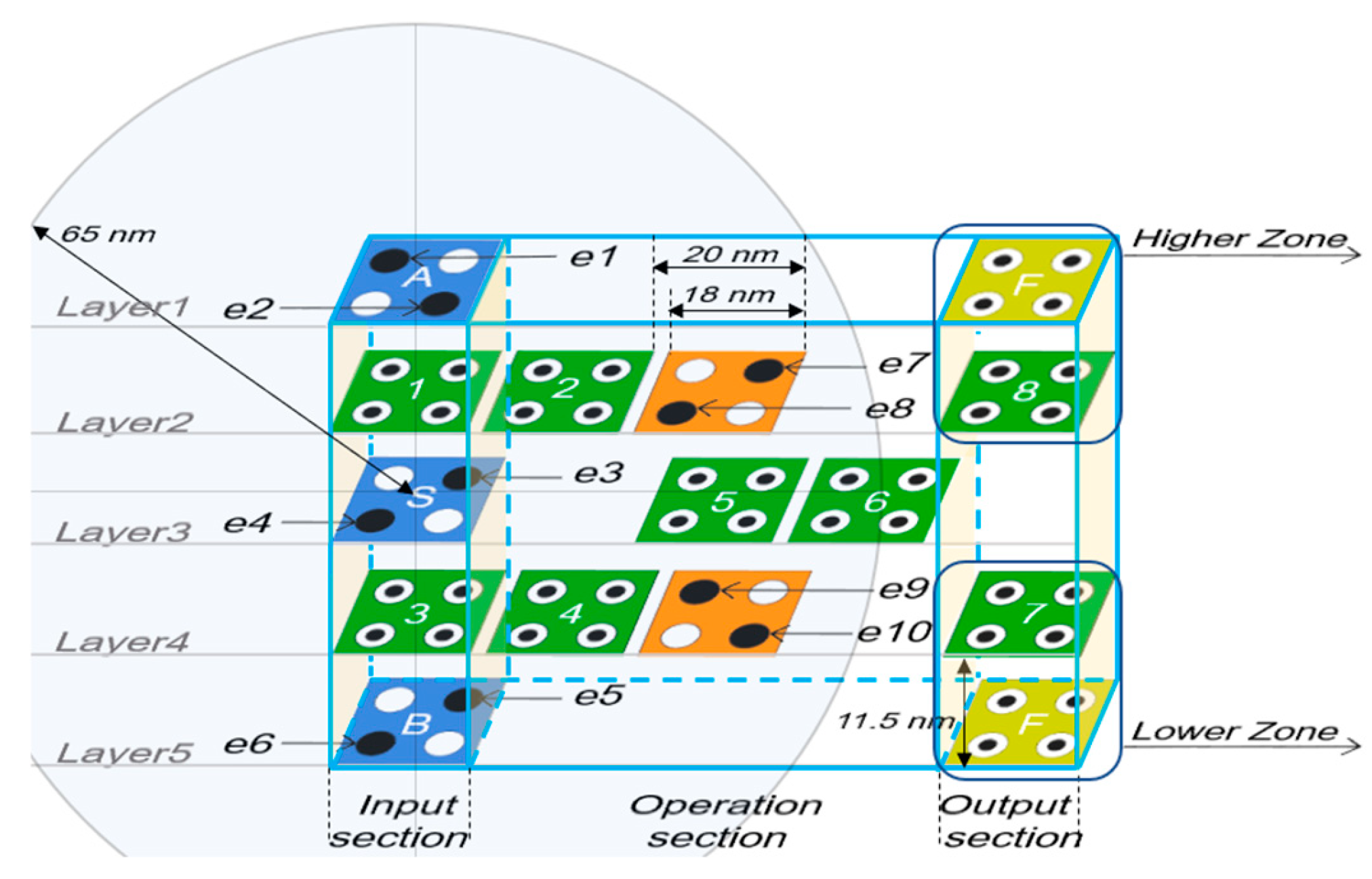

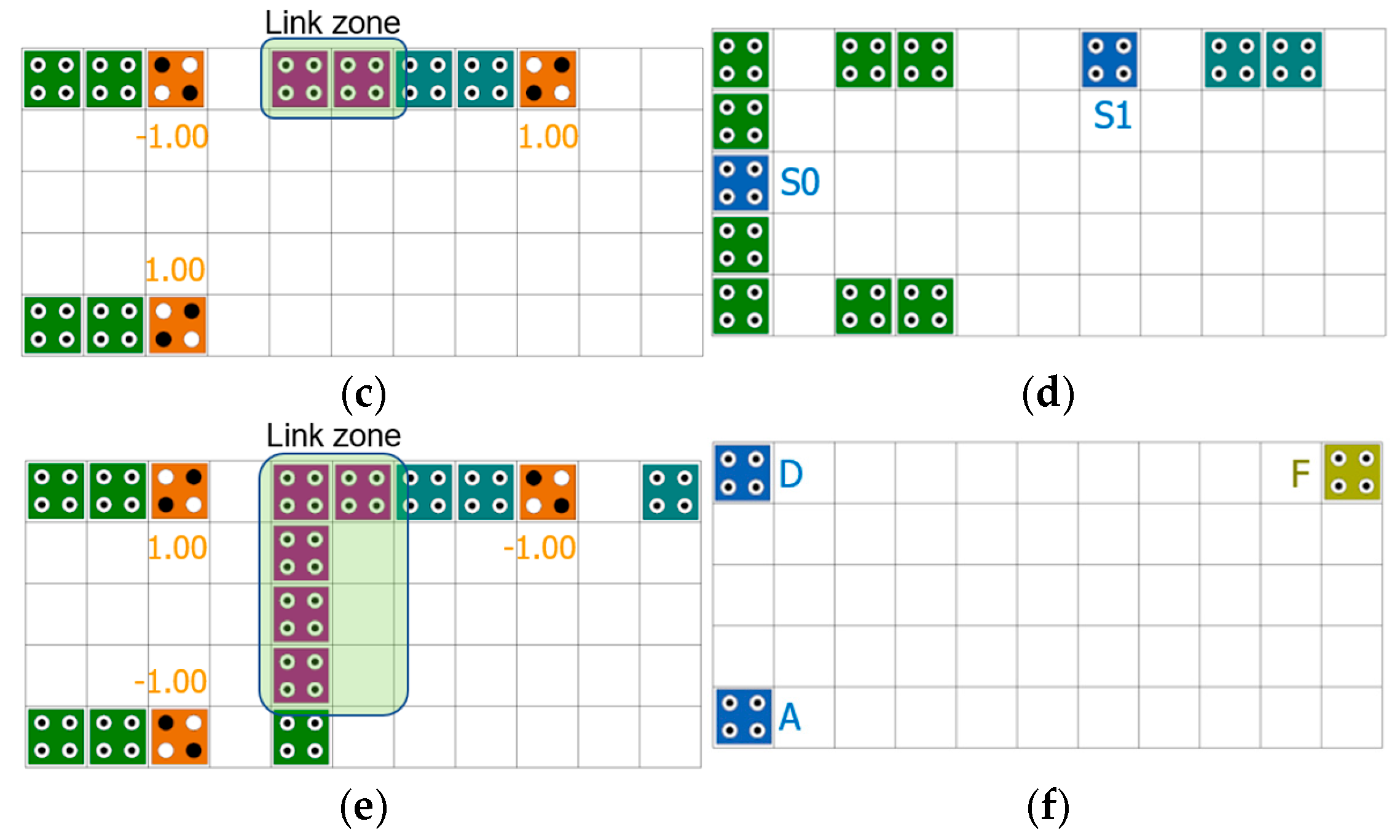
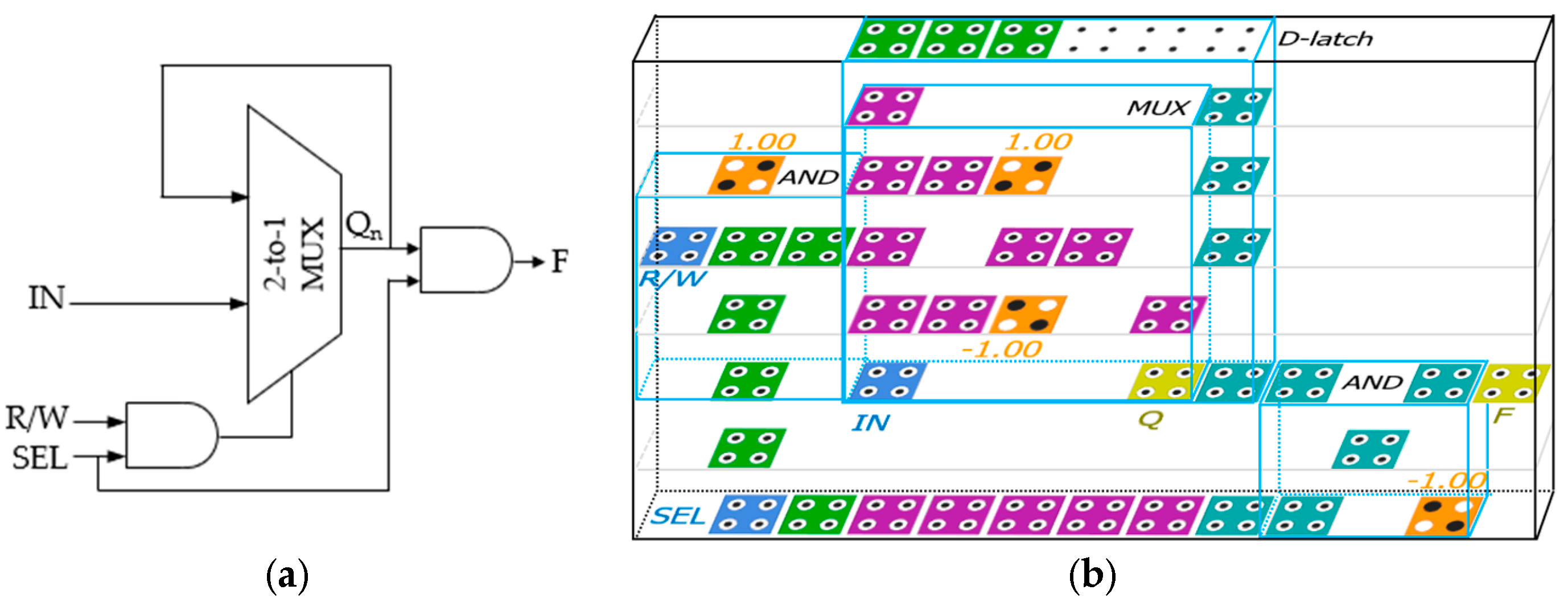

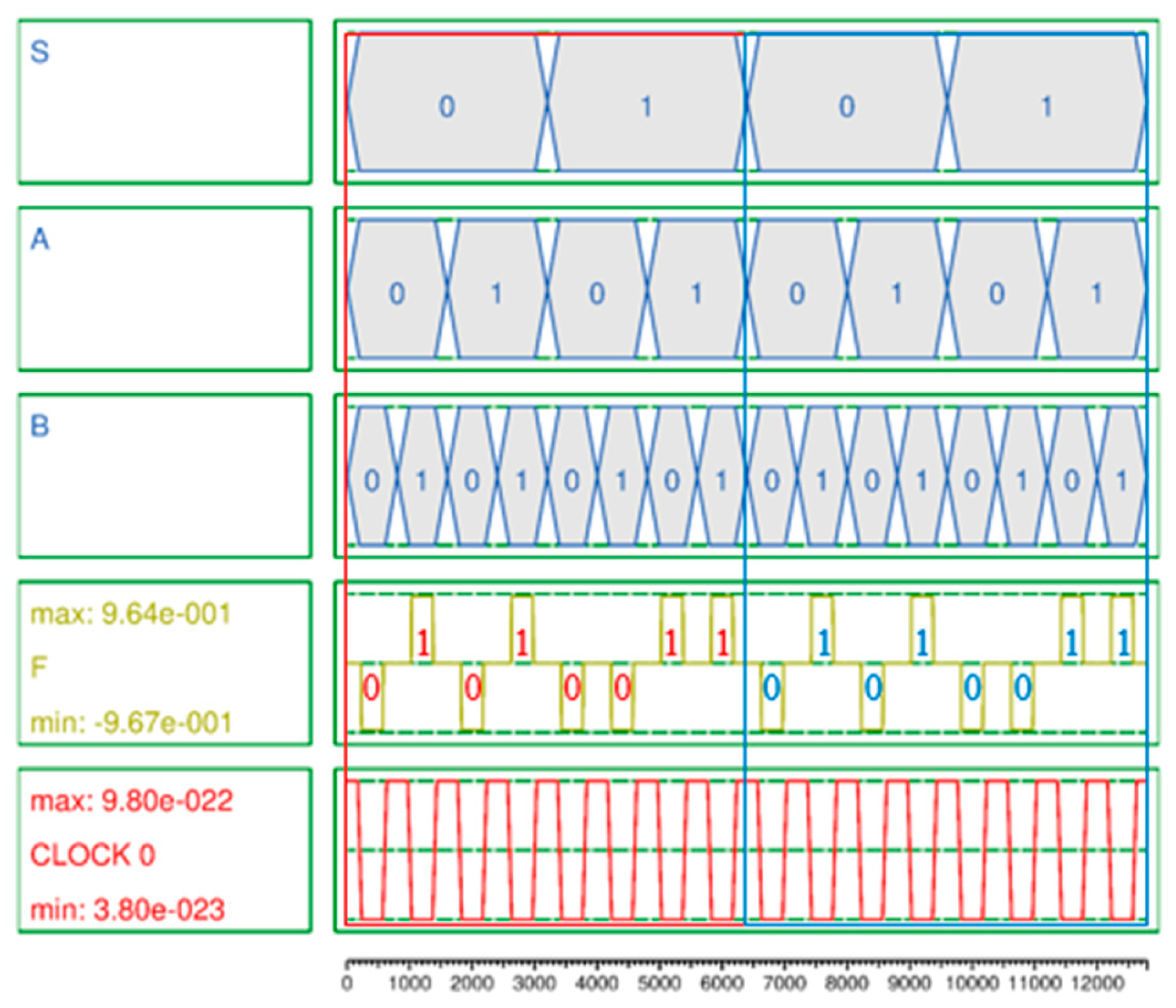
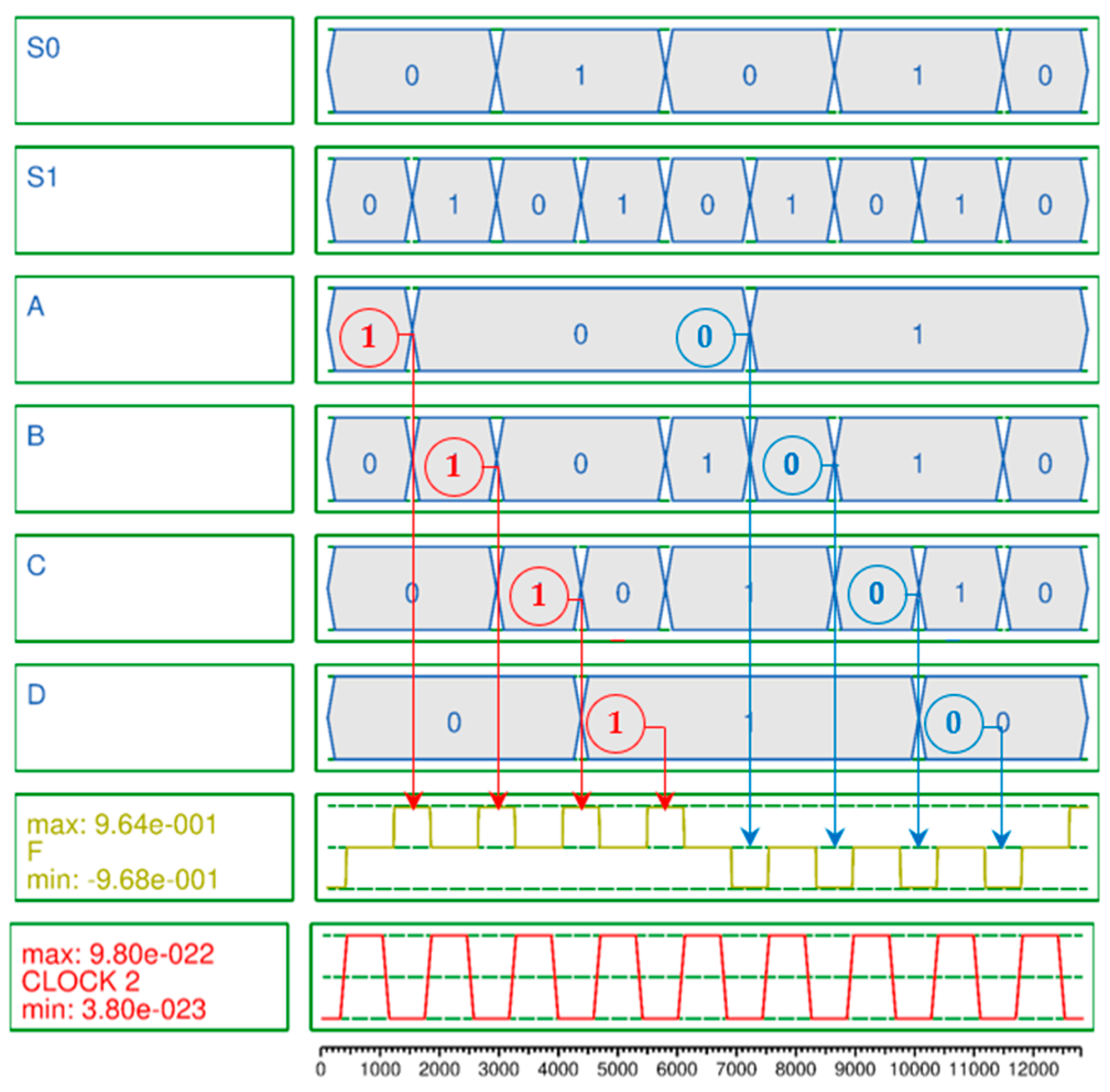

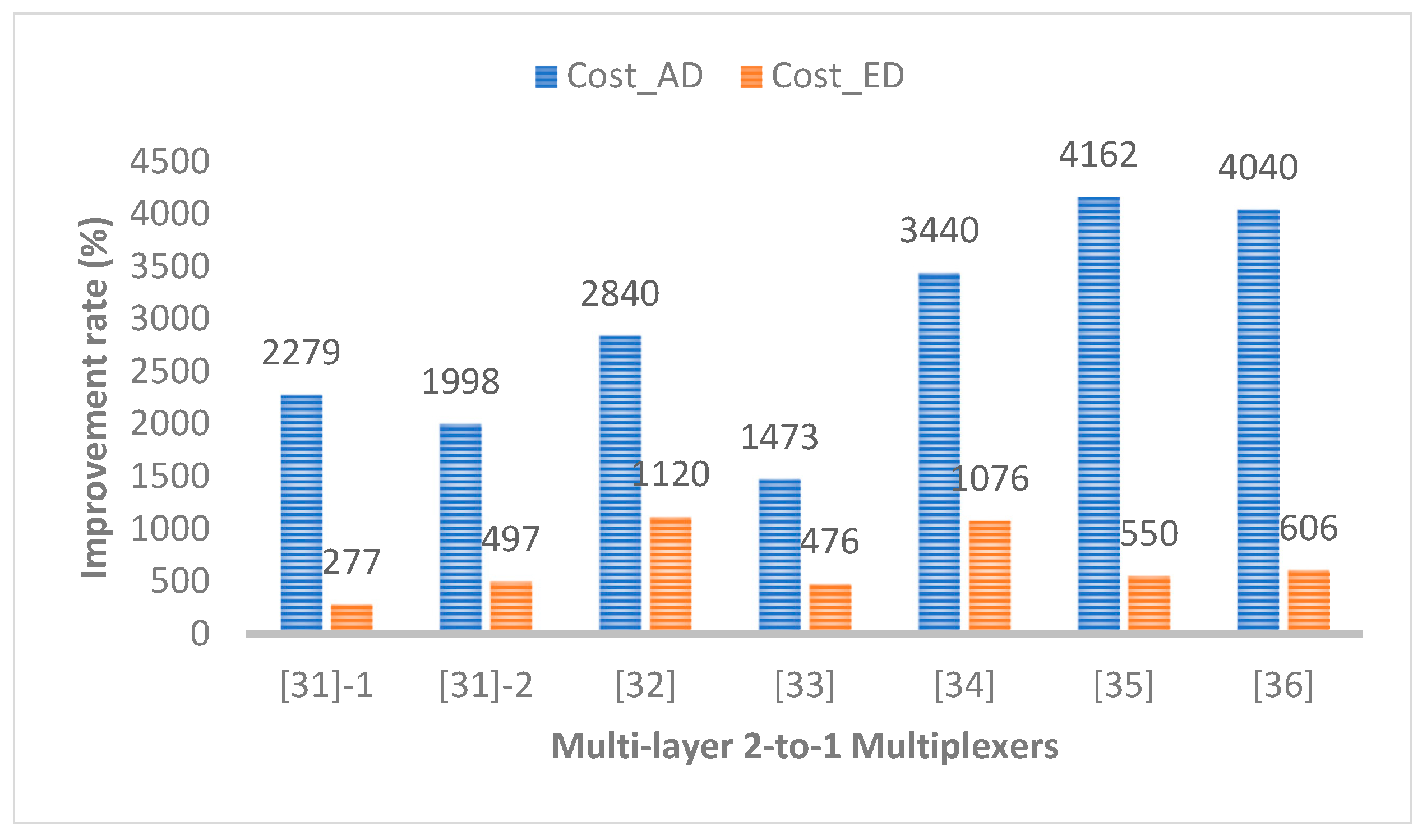
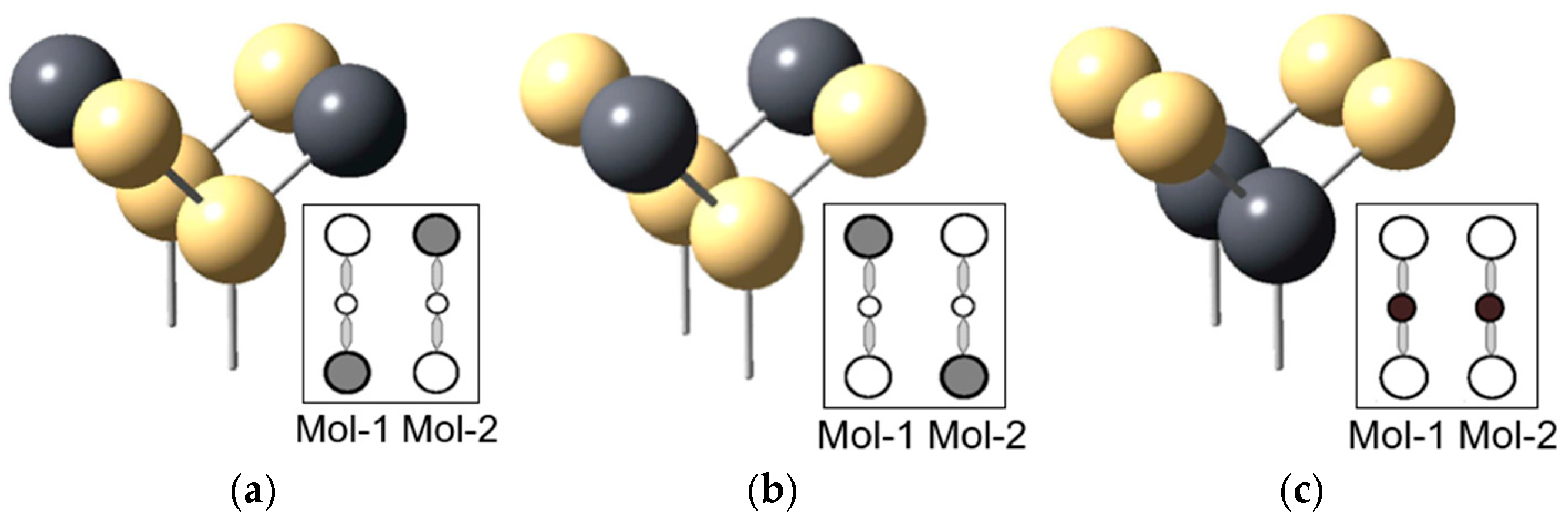
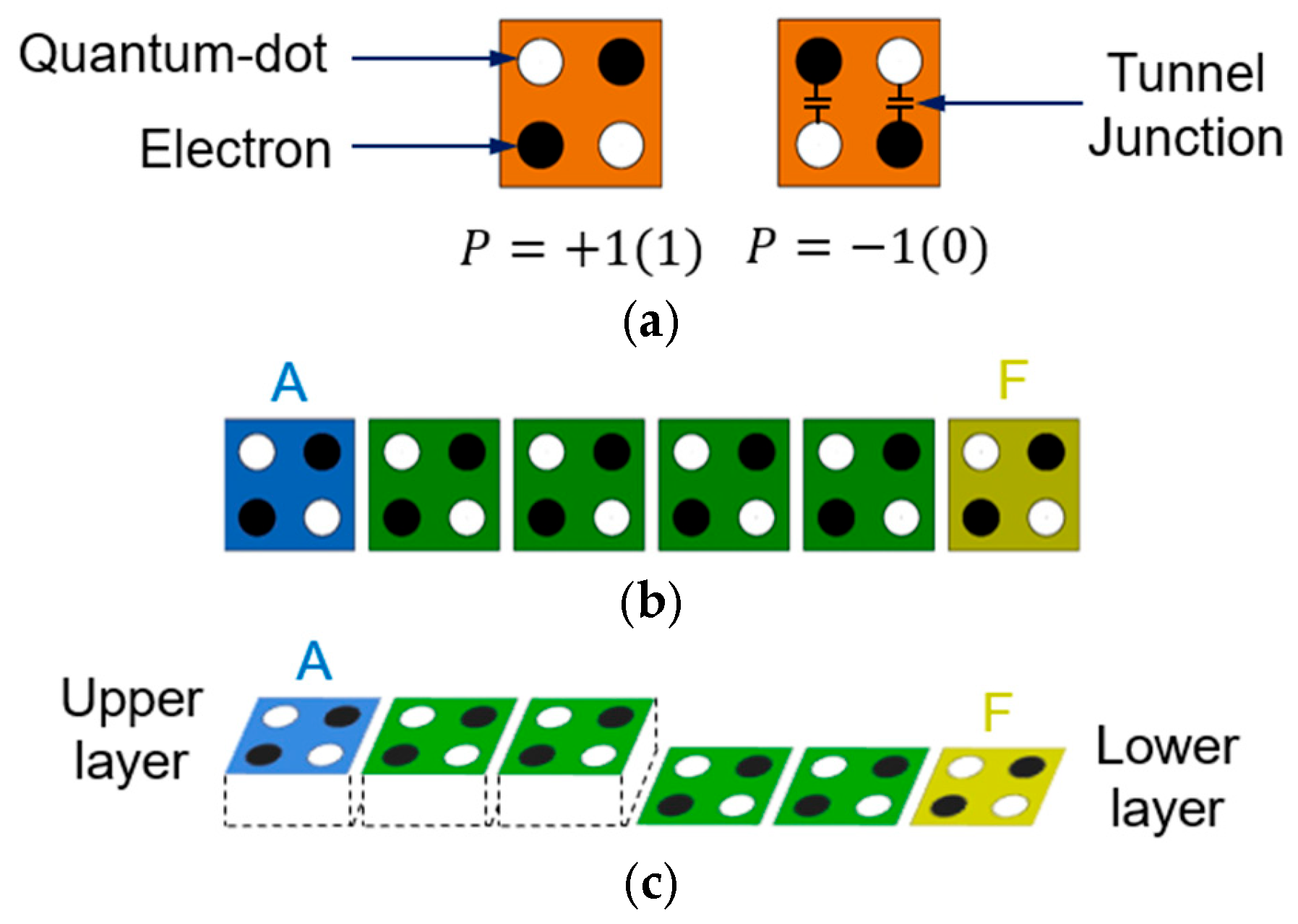


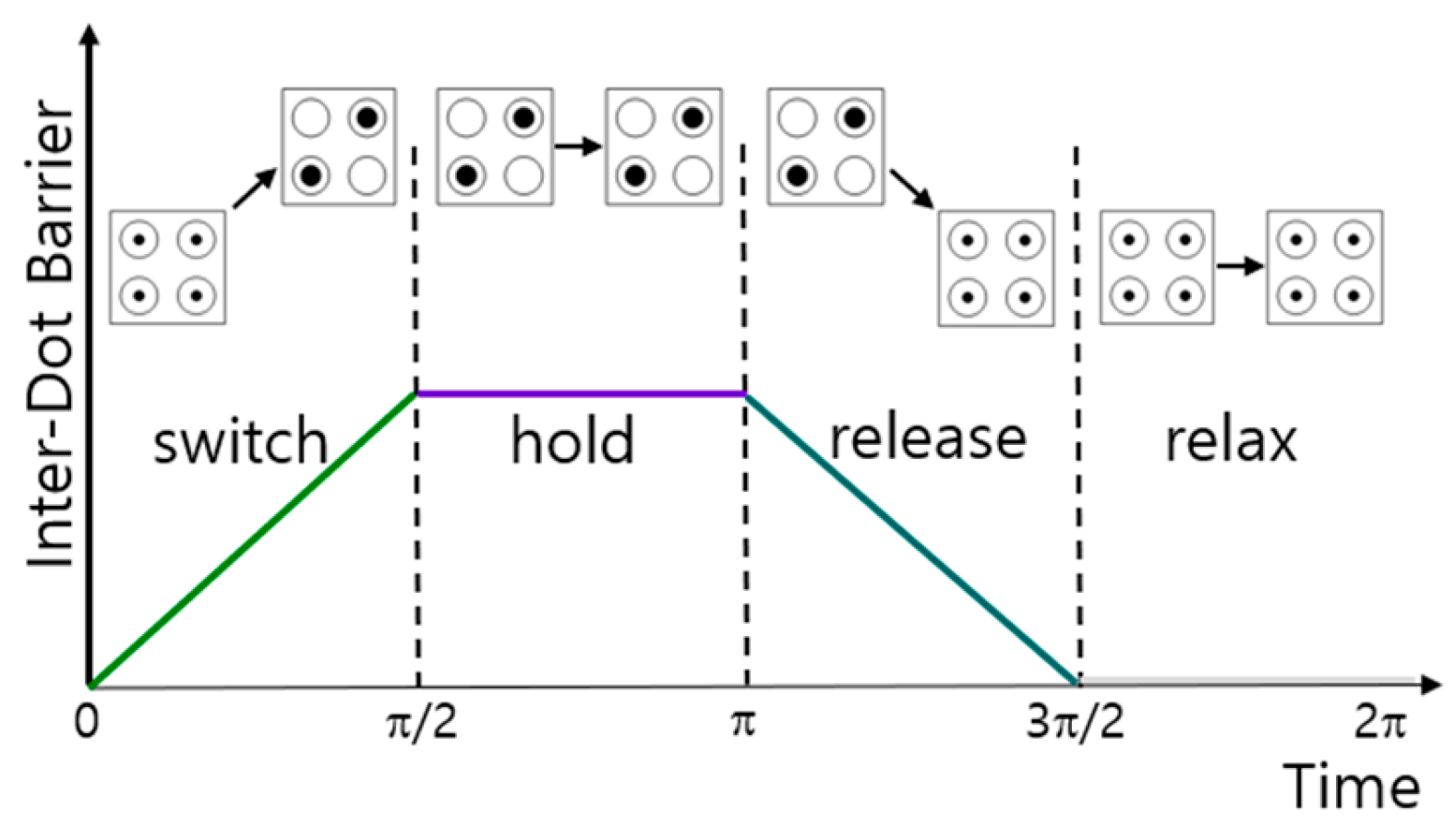
| S0 | S1 | A | B | C | D | F |
|---|---|---|---|---|---|---|
| 0 | 0 | 0 | X | X | X | 0 |
| 0 | 0 | 1 | X | X | X | 1 |
| 0 | 1 | X | 0 | X | X | 0 |
| 0 | 1 | X | 1 | X | X | 1 |
| 1 | 0 | X | X | 0 | X | 0 |
| 1 | 0 | X | X | 1 | X | 1 |
| 1 | 1 | X | X | X | 0 | 0 |
| 1 | 1 | X | X | X | 1 | 1 |
| SEL | R/W | IN | Qn-1 | Qn | F |
|---|---|---|---|---|---|
| 0 | X | X | X | Qn-1 | 0 |
| 1 | 0 | X | 0 | 0 (Qn-1) | 0 (Qn-1) |
| 1 | 0 | X | 1 | 1 (Qn-1) | 1 (Qn-1) |
| 1 | 1 | 0 | X | 0 | 0 |
| 1 | 1 | 1 | X | 1 | 1 |
| S | A | B | F |
|---|---|---|---|
| 0 | 0 | 0 | 0 |
| 0 | 0 | 1 | 1 |
| 0 | 1 | 0 | 0 |
| 0 | 1 | 1 | 1 |
| 1 | 0 | 0 | 0 |
| 1 | 0 | 1 | 0 |
| 1 | 1 | 0 | 1 |
| 1 | 1 | 1 | 1 |
| Circuit | Cell | Area | Delay | Ener. Dissi. | CostAD | CostED | ||||||
|---|---|---|---|---|---|---|---|---|---|---|---|---|
| no. | ratio | nm2 | ratio | clocks | ratio | 10−2 eV | ratio | AD2 | ratio | E2D2 | ratio | |
| [30] | 36 | 2.77 | 122,292 | 13.87 | 1.00 | 4.00 | 1.85 | 1.32 | 122,292 | 221.84 | 3.42 | 27.94 |
| [31]-1 | 23 | 1.77 | 52,452 | 5.95 | 0.50 | 2.00 | 1.36 | 0.97 | 13,113 | 23.79 | 0.46 | 3.77 |
| [31]-2 | 22 | 1.69 | 46,256 | 5.24 | 0.50 | 2.00 | 1.71 | 1.22 | 11,564 | 20.98 | 0.73 | 5.97 |
| [32] | 21 | 1.62 | 28,812 | 3.27 | 0.75 | 3.00 | 1.63 | 1.16 | 16,207 | 29.40 | 1.49 | 12.20 |
| [33] | 21 | 1.62 | 34,692 | 3.93 | 0.50 | 2.00 | 1.68 | 1.20 | 8673 | 15.73 | 0.71 | 5.76 |
| [34] | 24 | 1.85 | 34,692 | 3.93 | 0.75 | 3.00 | 1.60 | 1.14 | 19,514 | 35.40 | 1.44 | 11.76 |
| [35] | 25 | 1.92 | 41,772 | 4.74 | 0.75 | 3.00 | 1.19 | 0.85 | 23,497 | 42.62 | 0.80 | 6.50 |
| [36] | 20 | 1.54 | 40,572 | 4.60 | 0.75 | 3.00 | 1.24 | 0.89 | 22,822 | 41.40 | 0.86 | 7.06 |
| Ours | 13 | 1.00 | 8820 | 1.00 | 0.25 | 1.00 | 1.40 | 1.00 | 551 | 1.00 | 0.12 | 1.00 |
Disclaimer/Publisher’s Note: The statements, opinions and data contained in all publications are solely those of the individual author(s) and contributor(s) and not of MDPI and/or the editor(s). MDPI and/or the editor(s) disclaim responsibility for any injury to people or property resulting from any ideas, methods, instructions or products referred to in the content. |
© 2025 by the author. Licensee MDPI, Basel, Switzerland. This article is an open access article distributed under the terms and conditions of the Creative Commons Attribution (CC BY) license (https://creativecommons.org/licenses/by/4.0/).
Share and Cite
Jeon, J.-C. Multi-Layer Molecular Quantum-Dot Cellular Automata Multiplexing Structure with Physical Verification for Secure Quantum RAM. Int. J. Mol. Sci. 2025, 26, 9480. https://doi.org/10.3390/ijms26199480
Jeon J-C. Multi-Layer Molecular Quantum-Dot Cellular Automata Multiplexing Structure with Physical Verification for Secure Quantum RAM. International Journal of Molecular Sciences. 2025; 26(19):9480. https://doi.org/10.3390/ijms26199480
Chicago/Turabian StyleJeon, Jun-Cheol. 2025. "Multi-Layer Molecular Quantum-Dot Cellular Automata Multiplexing Structure with Physical Verification for Secure Quantum RAM" International Journal of Molecular Sciences 26, no. 19: 9480. https://doi.org/10.3390/ijms26199480
APA StyleJeon, J.-C. (2025). Multi-Layer Molecular Quantum-Dot Cellular Automata Multiplexing Structure with Physical Verification for Secure Quantum RAM. International Journal of Molecular Sciences, 26(19), 9480. https://doi.org/10.3390/ijms26199480






